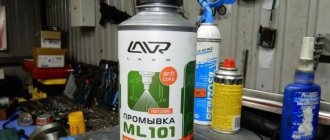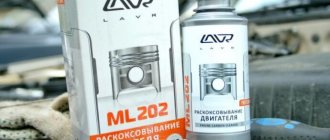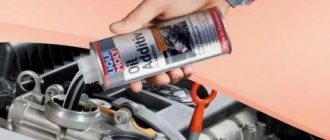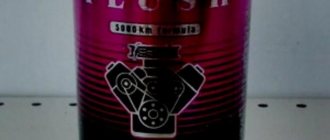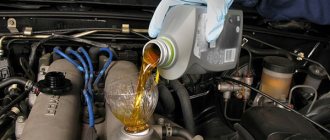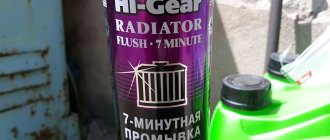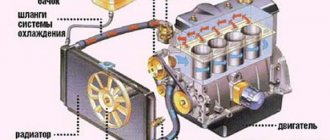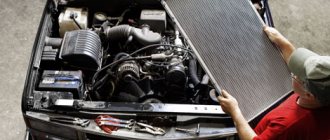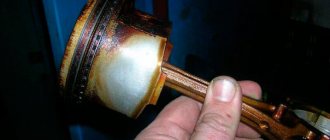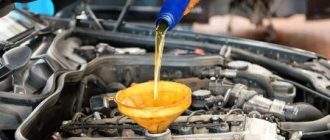Many drivers are well aware that during operation of an internal combustion engine, the lubrication system of the power unit gradually becomes contaminated. Often, contaminants are formed from breakdown products of the engine oil itself.
Also, one should not exclude various malfunctions, as well as common mistakes during internal combustion engine maintenance, which also do not add to the cleanliness of the oil system (engine overheating, antifreeze getting into the oil, mixing oils from different manufacturers, untimely replacement of lubricant, etc.).
One way or another, in such a situation, practically the only accessible and effective way to clean the engine without disassembling it is to use special engine flushes. However, not all car owners practice this approach, since such a solution has supporters and opponents.
In this article, we will look at whether or not to flush the engine before changing the oil, and will also focus on the popular composition, which is known to motorists as Laurel engine flush.
Cleaning: how to properly flush a car engine when changing the oil and when is the best time to do it
What to wash with
When the car is new, the problem of how to properly flush the engine when changing the oil does not arise. After all, it does not yet have a solid mileage, the owners say, in addition uttering a phrase about the inappropriateness of the internal combustion engine cleaning procedure. This is partly true, but it is worth remembering that the health of the power plant must be protected from a young age.
Recommendation. To avoid having to wash the power plant, you should pour only high-quality oil from new and not exceed its change interval of 7,500 km.
In the case of a new internal combustion engine, everything is clear. But what to do with contract engines and used cars. The answer is simple - clean the engine and fill it with new, high-quality lubricant.
Nowadays, the insides of the unit are cleaned not with flushing oil, but with catalyzing active chemistry. The special flush is a mineral oil with a package of aggressive additives. It comes in two types:
- five or seven minutes;
- soft (poured into oil 200-300 km before changing it).
Five minutes has a high content of alkaline and other caustic components. Experienced craftsmen express it this way: “It is recommended for use only on new engines or those that have been well cleaned by hand.” Soft flushing fluid causes fewer complaints, and among auto mechanics it is positioned as the only correct option.
How to clean
Initially, the cleaning composition is presented not as a product that washes the engine from the dirt that has accumulated there over several years, but as a detergent to maintain the cleanliness of a new or washed old engine. The conclusion here is that you cannot immediately pour the drug into an internal combustion engine with an unknown service history.
- drain the oil;
- remove the valve cover and oil pan;
- clean the removed elements with aggressive “medicines” (diesel oil, carburetor cleaner, kerosene...) and grinding;
- put everything in place;
- pour oil back;
- Wash the engine for five minutes.
We will analyze the cleaning procedure by rinsing using the LAVR cleaning composition as an example. According to reviews from admirers of the classic LAVR engine flush, the procedure for working with a five- or seven-minute composition looks like this:
- Warm up the engine to operating temperature.
- Turn off the car.
- Pour in the drug.
- Start up the internal combustion engine.
- Wait 5/7 minutes in idle mode.
- Stop the power plant.
- Drain the waste.
Attention! After cleaning with chemicals, the oil is changed to a new one. The filter must also be replaced.
This begs one question: why can’t we do without mechanical cleaning of power plant parts? Here's why: flushing will easily dissolve accumulated deposits in the crankcase and cylinder head. The latter will clog the oil intake screen, which will lead to oil starvation. This is deadly for a regular gasoline internal combustion engine and doubly bad for diesels and turbo engines. The way out of this situation is difficult - it is necessary to completely disassemble the engine and clean it.
It is noteworthy that when changing the oil base (for example, switching from mineral water to synthetic), you should not rinse with store-bought liquids. It is enough to drain the old one, fill in the new one and let the engine idle. Then the lubricant is drained again, the filter is changed, and the updated composition is filled in. You can do it another way:
- update the oil and replace the filter;
- drive 1,500-2,000 km.
Why do you need to flush the engine oil system?
So, even taking into account that the owner will use high-quality motor oil and change it regularly, contamination in the engine still cannot be avoided. The only thing is that the intensity of their formation will be reduced.
In other words, if you use, for example, cheap mineral oil or the most affordable semi-synthetic oil, and change such lubricant every 10-12 thousand km, then the engine will wear out more and become dirty very quickly. If you switch to hydrocracking or even synthetic oil with a replacement interval no later than 7-8 thousand km, then such an engine will remain clean much longer. However, the internal combustion engine must be serviced in this way from the very purchase of a new car.
Also, one should not assume that by 80-100 thousand mileage, even under such “ideal” conditions, deposits will not accumulate in the oil system. The reason is oil residues that cannot be completely drained as part of the replacement, heavy urban use, etc.
It becomes clear that pollution cannot be avoided. At the same time, it is also clear that it is optimal to remove them in advance for preventive purposes at the initial stage, before any problems begin with the engine (noisy operation, knocking of hydraulic compensators, decrease in pressure in the lubrication system, etc.).
Let us also add that car enthusiasts who change their oil 20-30% ahead of schedule often adhere to the opinion that an engine flush is not necessary when changing the oil. It is based on the assertion that the oil itself contains an active package of detergent additives that wash the engine and lubrication system.
Yes, this is true, but only partially. The fact is that a package of alkaline and other detergent additives is available, but in many cases it is not enough. Detergent additives work after 3-4 thousand km, that is, much earlier than the moment when the driver changes the oil again.
It turns out that you can wash the engine with oil, but to achieve results using this method, you will need to drain fresh oil several times literally every 2-3 thousand km. Obviously, such a procedure is very expensive in terms of budget.
At the same time, above we discussed only motors that were not very dirty to begin with. It often happens that the power unit has a mileage of about 200 thousand km. and more, the oil was changed according to dealer regulations without adjusting for operating conditions, there are doubts about the quality of the lubricant itself, frequent transitions were made from one type of oil to another, etc. In this case, it will take a very long time to wash the engine with oil alone, or it will not be possible to achieve the desired effect at all without using a special engine flush.
Having decided that flushing is necessary, the question arises of which oil system cleaner to choose. You should also take into account some features of using engine flushes and contraindications that also exist. Let's figure it out.
What kind of Hi-Gear soft flush is it for a car engine or reviews about it
Why is this composition called “soft”? It's simple - the additive package in mineral oil is selected in a way that is beneficial for the engine. Unlike express washes, the concentration of aggressive components is lower here, and they work for a long time. In addition, the composition from an American company does not destroy rubber elements - this has been proven by experiments.
About the effect of Hi-Gear soft engine flushing, the reviews are unanimous – positive. For example, here is what Oleg N. from Novosibirsk writes:
“After sitting for a long time, my Subaru Outback suddenly started smoking. I filled up High Gear, but decided not to drive, but to “roll out” 200 km in engine hours. As a result, the car stood for 4 hours, idling. There was much less smoke. And after 50 km of running on the new oil, everything returned to normal.”
Much has been said about the effectiveness of the cleaning product. It is worth noting that this is the most successful deoxidizer of bitumen and oily deposits. His credit is that he does his job slowly. This means that malignant products will dissolve into small substances, mix with oil and, without clogging the meshes and small channels, come out as waste. This is confirmed by Nikolay M. from Tula, who has tried almost the entire Hi-Gear washing line. He formulated his review briefly:
- a soft drug is an effective and harmless thing;
- five-, ten-minute periods - they are washed, but the entire oil system is clogged with sludge;
- Flushing oils clean, but significantly damage camshafts and camshafts.
Laurel: engine flushing, instructions, features of use
Let us immediately note that there are a large number of solutions for flushing the lubrication system on the market: Liqui Moly, Lavr, Xado, Hi-Gear, etc. You can also find so-called flushing oil, while in the Russian Federation drivers usually choose Lukoil or Zic.
Given such diversity, we decided to focus on one of the most widely represented and most popular products among engine flushes. We are talking about products under the Lavr brand.
As you can see, the most convenient and widespread is a preparation for flushing the oil system, which:
- poured directly into the mining;
- does not react dangerously with motor oil;
- maintains the required oil viscosity when flushing;
- effectively removes sludge and other deposits;
- does not have a pronounced negative effect on oil seals and seals;
In short
- A competent flushing procedure first involves mechanical cleaning of the oil sump and valve cover, only then using auto chemicals. The essence of its application is simple - pour the composition into the oil, let the engine run and, depending on the type of flushing, drive with it. Next, the waste is drained, the filter is changed and new lubricant is refilled.
- When changing the oil base (synthetic - semi-synthetic, etc.), it is advisable to wash it with new oil, which is planned to be refilled further.
- There are accelerated washes and long-acting formulations, called soft ones. The latter have the advantage.
- Reviews of the Hi-Gear soft product are positive. In the technology of how to properly flush a car engine before changing the oil, there are cases when the flushing life is not rolled out in kilometers, but is developed in engine hours. This technology is less harmful to the engine, and the effect is almost the same.
- The LAVR line of automedicines is highly effective. The most popular is the “soft” liquid Motor Flush Soft.
This post is also more for myself)) Decoked and changed the oil! in 2 hours the liquid was completely gone, although this time I took 330 ml... here is the description of the procedure. Oil as always, and additionally did a rinse with a 5-minute LAVR rinse (I have never rinsed, but this time I decided to do it additionally after decarbonization) Plus I changed the air)
Method of use for cleaning the engine oil system:
Warm up the engine to operating temperature. Pour the drug into the oil filler neck and start the engine. Let it idle for 5 minutes. YOU CAN'T DRIVE A CAR! Stop the engine and drain the used oil. Replace the oil filter and add new oil.
LN2504 LAVR Engine decoking fluid -330.00 RUR; LN1003 LAVR Flushing the internal combustion engine -113.00 RUR; PAA033 PARTS MALL Air filter -144.00 RUR; W81180 MANN Oil filter -RUB 186.00
«The debate about the need for engine flushing has recently intensified. And all due to the fact that more and more used cars are appearing on the market than new ones. Panacea? Or harm? Are there many engine oil system flushes that are actually effective? Let's deal with everything in order.
»
The wash is poured into the oil before changing, mixed with the lubricant that has already exhausted its resource, and allowed to work for some more time (most often 5.10 minutes). Then the resulting liquid is drained and fresh oil is poured into the engine. All of these products contain cleaning additives similar to those found in regular motor oil or exclusively solvents. It is this fact that causes many to doubt whether such a composition will be able to wash away the sludge, oil and fuel combustion products that have accumulated over the years, in a few minutes or at least a couple of days of work.
You can flush the engine with several means - flushing oil, oil or a liquid with which you need to drive for a while. But the most popular remedy is a 5-minute engine flush . Since the last two drugs are used most often - due to their ease of use, we will consider their effectiveness in more detail.
Popular” flushes
Let’s briefly look at five-minute engine flushes, popular in the Russian Federation.
- Liqui Moly Engine Flush . Available in 300 ml bottles. This volume is enough for a one-time flush of any passenger car engine. The product is poured 5-10 minutes before the lubricant is drained from the system onto the hot engine. During cleaning, the engine should not be given high speed. It has noticeable efficiency and copes well with non-old deposits. The cost of one can is about 380 rubles.
- Hi-Gear 5 Minute Motor Flush Gas & Diesel Engines . Effective flushing. Available in 444 ml cans. Has a large number of positive reviews online. Works similarly to the tool described above. The only drawback is the rather high price. You will have to pay about 400 rubles for a bottle.
- Lavr 5-minute engine flush “Classic” . Perhaps the most popular remedy in the Russian Federation. Sold in 250 ml bottles. Cleans the engine of relatively fresh sludge and varnish deposits. Increases the volume of drained waste (reduces the amount of old oil residue). It has gained popularity in the Russian Federation due to its low price and high efficiency. The price per jar fluctuates around 230 rubles.
These three products, according to some sellers of automotive chemicals, cover about 90% of the total demand for 5-minute engine flushes in Russia.
How does flushing work?
Quick (five-minute) flushing of the engine lubrication system works using a fairly simple method. This composition is poured into the lubrication system, after which the engine should run for about 5 - 10 minutes, and the liquid resulting from mixing is drained. The composition of the product for flushing into the oil before changing includes a large (so-called shock) dose of detergent components . Which in a short time can wash away old dirt, scale, deposits and other debris. This is evidenced by numerous engine flush tests. Their results can be found in sufficient quantities on forums and various resources on the Internet.
Sometimes on the Internet you can find conflicting reviews about a particular product, the essence of which boils down to a negative effect. However, this attitude is often the result of improper application of flushing. If the product contains aggressive substances, then with prolonged exposure to rubber seals there is a risk of damage to the latter. And this leads to an emergency situation. Therefore, before using this or that product, you must carefully read the instructions for its use and act in accordance with it.
Looking ahead, it is worth noting that the effect of using such rinses is indeed observed, but it is not as fantastic as their manufacturers write in the instructions . Therefore, the appropriateness of use remains questionable.
How do five minutes work?
The principle of operation of 5-minute engine flushes is in the name. The general essence of how such products work is similar for all manufacturers.
Before changing the oil, five minutes is poured into the engine through the oil filler neck. Then the engine runs at low or medium speed for 5 to 30 minutes. After this, the used oil is drained. During this time, the additive actively dissolves sludge and varnish deposits and removes them along with used oil from the engine.
5-minute oils have several advantages over flushing oils:
- easier way to use;
- lower final cost of washing;
- a more pronounced effect when it is necessary to remove old deposits;
- The washing procedure takes a little time.
These funds also have disadvantages:
- excessively aggressive effect on the seals (if you leave the five-minute flushing in the engine longer than the regulated period, this can lead to destruction of the rubber seals).
- increased likelihood of a large slurry element peeling off from the internal surface of the internal combustion engine and getting into the oil channel (with subsequent limitation or complete cessation of oil flow through it).
Therefore, five-minute periods should be used carefully and only when necessary. For preventative flushing, it is better to use softer, high-grade flushing oils.
What means are used to flush the engine?
Despite the fact that most washes act similarly, they are still divided into several classes. Among them:
- "Five Minutes" . As a rule, they are based on an organic solvent, which allows you to quickly and rapidly wash away dirt and deposits. The advantage of such products is their high speed of action. Disadvantages - along with dirt, the “five-minute” can wash away the lubricant from working mechanical pairs. As a result, scratches may appear on the parts. Therefore, such drugs can only be used when the engine is idling.
- Soft engine flushes . They are added to the oil approximately 100.300 kilometers before the scheduled oil change. They act more gently than previous products, since their base is created from calcium sulfonates (something like soap and similar detergents). In addition to the base, the composition includes dispersing additives.
- A mixture of the first two options . These can be a variety of compositions containing both solvents and detergent components with additives. As practice shows, universal tools are not as good as special ones tailored to solve a specific problem.
There is another class of rinses, which can conditionally be called folk, but they also belong to the “hard” class. For decades, before the advent of modern chemicals, motorists added various solvents, including acetone or solvent . This solution does exist, but with some limitations:
- The effect of such remedies is very limited in time. They are allowed to work literally for 3.5 minutes. Naturally, during this time they will only be able to wash off surface deposits.
- Under no circumstances should you increase the speed when there is such a flush in the engine!
As an example, we list several popular compounds belonging to certain classes (naturally, their true number is many times greater).
Remember that all of the listed remedies are preventative and are not intended to decarbonize the engine. And also that before filling in new permanent oil, it is advisable to purge the system with a compressor or use a vacuum pumping device in order to remove all remaining oil mixture in the engine (after traditional draining, about 200.300 grams always remain).
Let's sum it up
As you can see, the manufacturer’s statements and the prescribed properties of flushing preparations may differ from the actual composition of lubrication system cleaners. Moreover, this situation is observed not only with Lavr products, but also with other solutions.
In practice, this means that it is still not recommended to load the engine or drive while flushing, even if the manufacturer of a particular composition indicates this possibility. It should also be remembered that flushes can peel off from the walls of the pan, but do not dissolve dense deposits and thereby clog the oil receiver mesh. The result is oil starvation of the internal combustion engine.
Taking into account the above, it becomes clear that the use of flushes for the engine lubrication system is considered a useful procedure in some cases, but one should not forget about the above risks. This statement is true both for LAVR washes and for other manufacturers.
Types and principle of operation of flushing liquids. In what cases is it necessary to flush the engine? When you should not use an engine flush before changing the oil.
Whether or not it is necessary to flush the engine before changing the oil. Test of popular engine lubrication system flushes. Test results, useful tips.
Affordable solutions for flushing the engine before changing the engine oil. How to wash the engine with special washes, flushing oil or diesel fuel.
Flushing compositions for cleaning the Hi-Gear engine lubrication system: features, advantages and disadvantages of Hi-Gear flushes. Useful tips for flushing the internal combustion engine.
Carbon formation and consequences of engine coking. The occurrence of piston rings, the appearance of deposits and varnish on parts. How to remove carbon deposits yourself.
Means and methods for flushing the engine before changing engine oil. Is it necessary to flush the engine, with what compounds and in what cases is it necessary?
The automotive world is divided: some owners are trying to prove that flushing is unnecessary and even harmful, while others, on the contrary, strive to wash the engine with every oil change. It is very difficult for a simple car enthusiast to get an answer to this question: specialized automobile publications turn tests into advertising, and then whoever pays calls the tune.
LAVR specialists decided to once and for all answer one of the most painful automotive questions, which causes fierce debate in car repair shops, garages and on automobile forums. LAVR publishes its expert opinion on flushing the engine lubrication system.
We have systematized our scientific and experimental knowledge, and in this article we will justify the procedure and tell you which washes should be used and when.
Brief history
In Russia.
The first indirect evidence that the engine needs flushing is the very fact that such liquids appeared in the late 1960s and early 1970s simultaneously in the USSR and the West. In the Soviet Union, engine flushing was developed for cleaning low-speed diesel locomotive engines, and the technical fluid for this procedure was liquid mineral oil with a reinforced package of detergent additives. The washing process was quite long - 30 minutes or more. Later, the method, without any special changes, migrated to passenger vehicles; special flushing oils were produced, the sale of which domestic companies were very successful.
